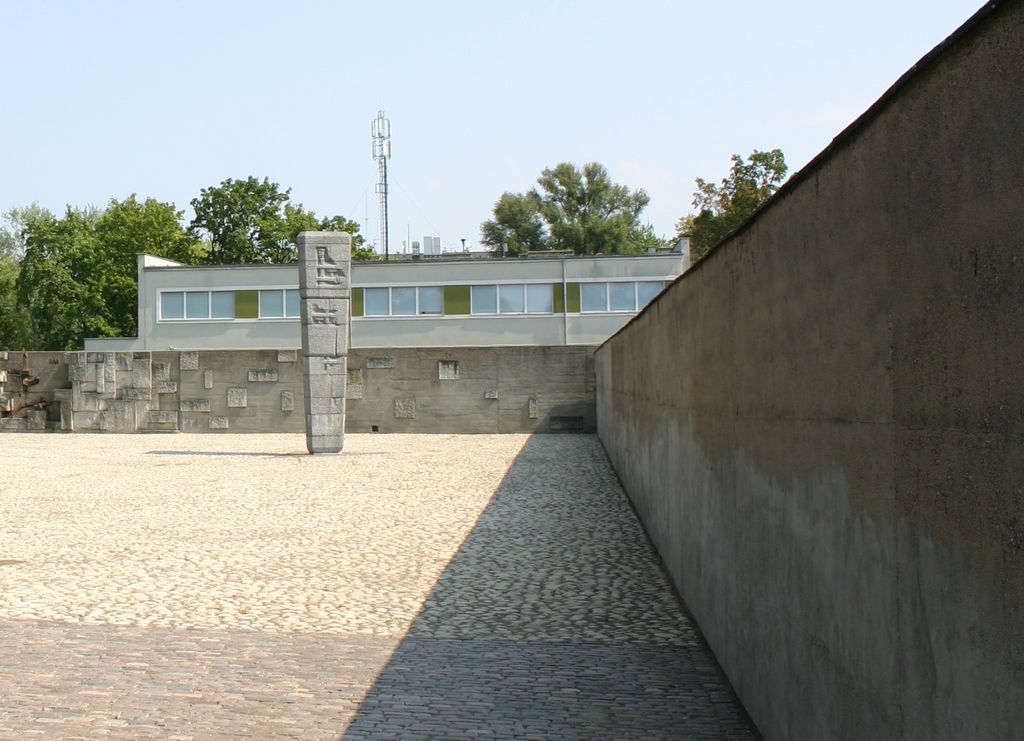Obelisk in Honour of the Victims of Pawiak Prison, 1963
Obelisk in Honour of the Victims of Pawiak Prison, 1963
Photo: Sabine Arend, 2015
Before being deported to the Ravensbrück concentration camp, Zofia Pociłowska was held in Pawiak Prison in Warsaw for several days. The prison was located in what was then the Warsaw Ghetto, and it was used by the Gestapo to detain political and Jewish prisoners. During the Warsaw Uprising in August 1944, the Gestapo blew up the building and murdered the remaining prisoners. On the initiative of former prisoners, the Muzeum Więzienia Pawiak (Museum of Pawiak Prison) opened on the site in 1965. As early as 1963, a monument was dedicated in the restored prison yard following a design competition. Zofia Pociłowska won this competition and thus received one of her first official commissions for a monument.
The monument in the walled inner courtyard of the museum is a three-sided obelisk hewn from granite which tapers towards the bottom. At a height of around seven metres, it is also visible from the two adjacent streets. It stands in the middle of a red triangle, the symbol used by the Nazis to identify political prisoners in the concentration camps. The obelisk is composed of elements of various sizes and divided into three blocks stacked on top of one another, the sides of which have been roughly hewn in bas-relief. The relief on one side depicts crossed bars, behind which stylized faces can be seen. Another relief shows an upright body with a raised arm, underneath which is a person with their face in their hands. An execution scene is depicted as well. The reliefs generally appear sketchy, or as if they have only partially been laid bare. Some of the faces look mute and anonymous, others distorted by mouths opened as if screaming, others determined and unbroken. The work creates an impression of imprisonment and desperation, but also resistance and hope for a better future. According to Pociłowska, one group of faces is meant to represent the survivors of Pawiak Prison who were building the new Poland. This likely explains the lack of Christian motifs which are commonly found in the artist’s other monumental projects, such as Pietà or the memorial stele in Magdalenka near Warsaw. A more sober historical approach with a clear outlook on the future seems to take precedence here.
In this respect, the work is in keeping with the Polish monumental discourse of the 1950s. The choice of material is also typical of the time. Pociłowska was able to defend her concept against criticism from the Academy of Fine Arts and the museum’s design commission. She succeeded in ensuring that the monument was erected in a central part of the museum. She also refused to carry out the work together with a colleague.
However, she had to accept that Tadeusz Łodziana and Stanisław Slonina designed the wall of the inner courtyard with metal sculptures that trap her own monument. Pociłowska’s stele has now receded into the background as a place of remembrance. Victims of the prison are now commemorated at the bronze elm tree next to the entrance to the museum complex, where family members have placed memorial plaques.
The permanent exhibition of the Pawiak Museum includes six smaller-scale sculptures which Pociłowska created in the 1990s using her typical technique of glazed ceramic.
Miguel de Andrade, Art History and Gender Studies student

